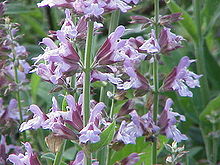Salvia
| Salvia | |
|---|---|
 |
|
| Common sage (Salvia officinalis) | |
| Scientific classification | |
| Kingdom: | Plantae |
| (unranked): | Angiosperms |
| (unranked): | Eudicots |
| (unranked): | Asterids |
| Order: | Lamiales |
| Family: | Lamiaceae |
| Subfamily: | Nepetoideae |
| Tribe: | Mentheae |
| Genus: |
Salvia L. |
| Type species | |
|
Salvia officinalis L. |
|
| Species | |
| Synonyms | |
|
Synonyms
|
|
Salvia is the largest genus of plants in the mint family, Lamiaceae, with nearly 1000 species of shrubs, herbaceous perennials, and annuals. Within the Lamiaceae, Salvia is part of the tribe Mentheae within the subfamily Nepetoideae. It is one of several genera commonly referred to as sage.
The genus is distributed throughout the Old World and the Americas, with three distinct regions of diversity: Central and South America (approx. 500 species); Central Asia and Mediterranean (250 species); Eastern Asia (90 species).
Salvia species include annual, biennial, or perennial herbs, along with woody subshrubs. The stems are typically angled like other members in Lamiaceae. The leaves are typically entire, but sometimes toothed or pinnately divided. The flowering stems bear small bracts, dissimilar to the basal leaves—in some species the bracts are ornamental and showy.
The flowers are produced in racemes, or panicles, and generally produce a showy display with flower colors ranging from blue to red, with white and yellow less common. The calyx is normally tubular or bell shaped, without bearded throats, and divided into two parts or lips, the upper lip entire or three-toothed, the lower two-cleft. The corollas are often claw shaped and are two-lipped. The upper lip is usually entire or three-toothed. The lower lip typically has two lobes. The stamens are reduced to two short structures with anthers two-celled, the upper cell fertile, and the lower imperfect. The flower styles are two-cleft. The fruits are smooth ovoid or oblong nutlets and in many species they have a mucilaginous coating.
...
Wikipedia
